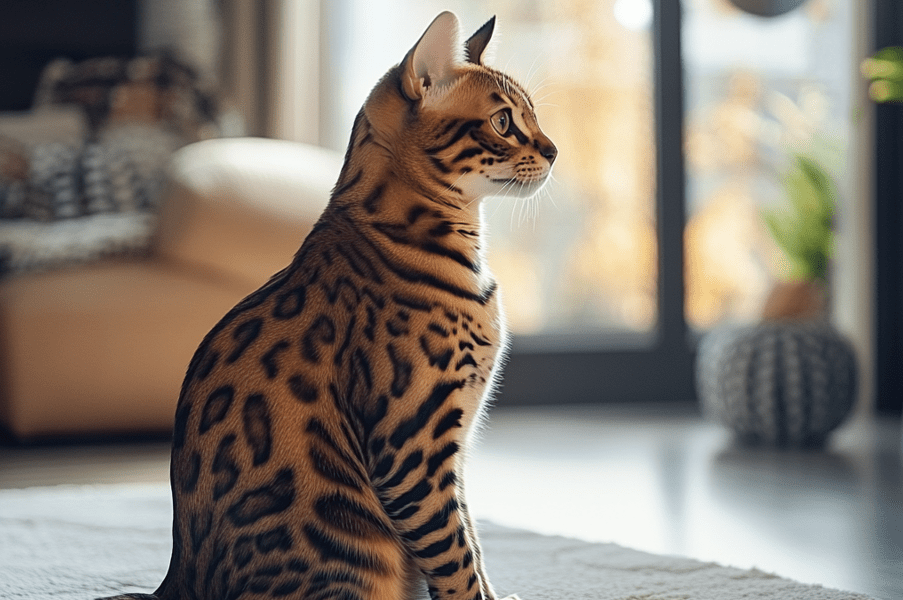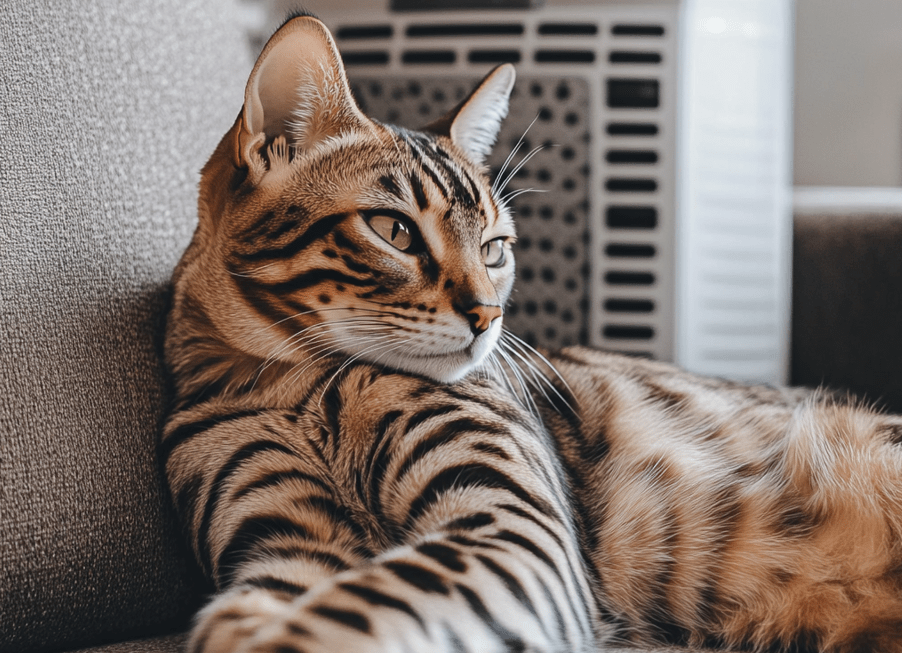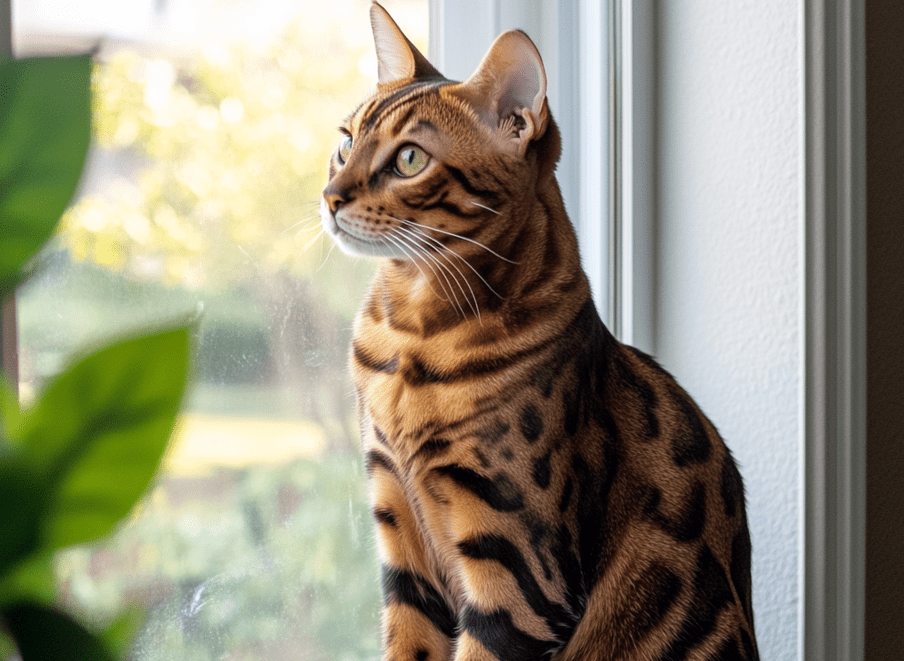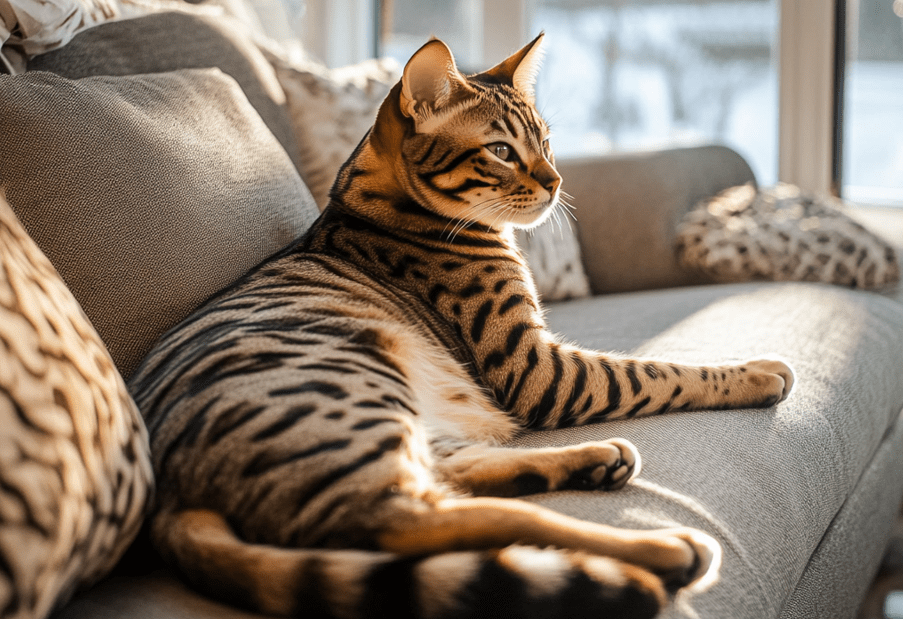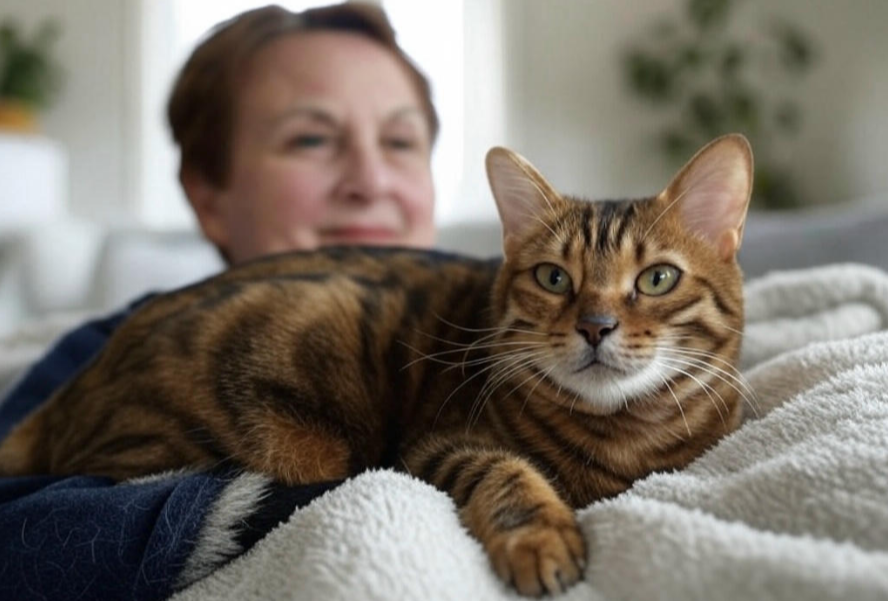
Bengal cats, with their stunning leopard-like coats and playful personalities, are beloved companions for many. However, some Bengal cat owners notice their feline friends struggle with a sensitive stomach, leading to issues like vomiting, diarrhea, or picky eating. Understanding why your Bengal has a sensitive stomach and finding effective solutions can significantly improve their quality of life. This comprehensive guide explores the causes of sensitive stomachs in Bengals, offers practical solutions, and provides tips to keep your cat healthy and happy.
What Is a Sensitive Stomach in Bengal Cats?
A sensitive stomach in Bengal cats refers to a digestive system that reacts adversely to certain foods, environmental factors, or stressors, resulting in symptoms such as:
1.Vomiting (occasional or frequent)
2.Diarrhea or loose stools
3.Flatulence or bloating
4.Reduced appetite or food refusal
5.Lethargy after eating
These symptoms can range from mild to severe and may be temporary or chronic. Identifying the root cause is key to managing your Bengal’s digestive health effectively.
Common Causes of Sensitive Stomachs in Bengal Cats
Bengal cats are prone to sensitive stomachs due to a combination of genetic, dietary, and environmental factors. Below are the most common reasons your Bengal may experience digestive upset.
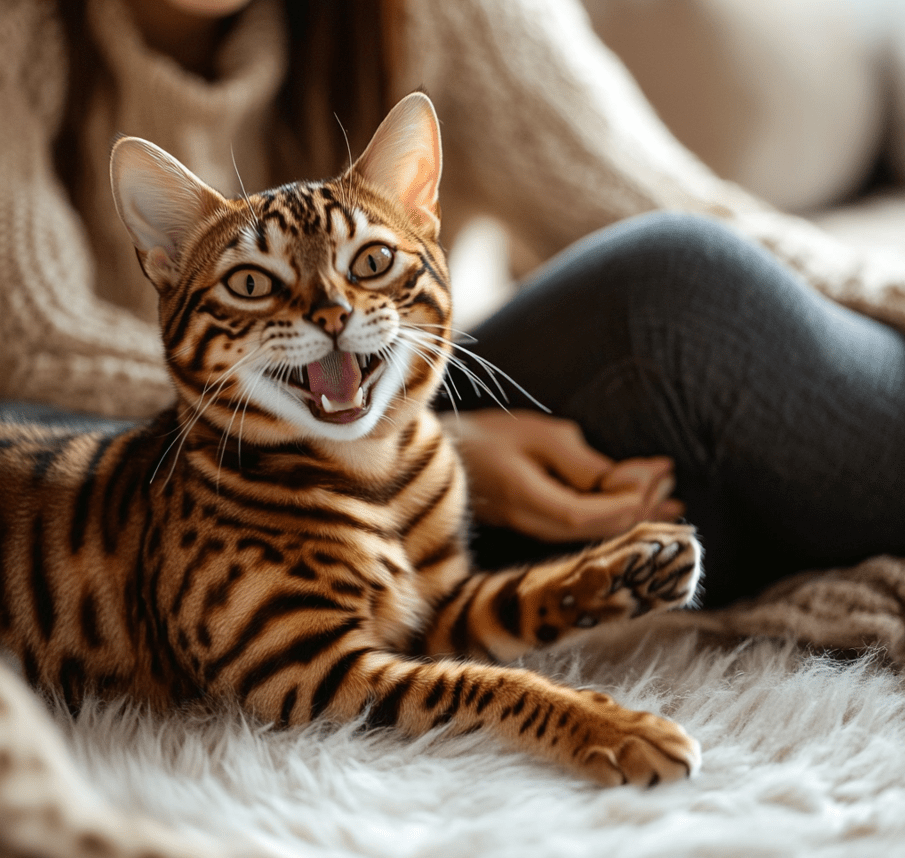
1. Dietary Sensitivities and Food Allergies
Bengals may have sensitivities or allergies to specific ingredients in their food, such as:
Proteins: Chicken, beef, or fish are common allergens for cats.
Grains: Corn, wheat, or soy can irritate some Bengals’ stomachs, especially if they have grain sensitivities.
Artificial Additives: Preservatives, dyes, or flavorings in low-quality foods can trigger digestive issues.
Lactose: Many cats, including Bengals, are lactose intolerant, making dairy products problematic.
Symptoms of food allergies often include vomiting, diarrhea, and skin issues like itching or hair loss.
2. Poor-Quality or Inappropriate Diets
Feeding your Bengal a diet that doesn’t meet their nutritional needs can lead to digestive problems. Common issues include:
- Low-quality commercial foods with fillers or by-products
- Abrupt diet changes, which disrupt gut flora
- Overfeeding or feeding human foods (e.g., spicy or fatty scraps)
Bengals, being active and muscular, require high-protein, nutrient-dense diets to support their energy levels and digestion.
3. Stress and Anxiety
Bengals are intelligent, high-energy cats that thrive on stimulation. Stressors like moving, new pets, or lack of enrichment can cause gastrointestinal upset. Stress-induced sensitive stomachs may present as vomiting or diarrhea during or after stressful events.

4. Gastrointestinal Disorders
Underlying medical conditions can contribute to a sensitive stomach, including:
Inflammatory Bowel Disease (IBD): Chronic inflammation of the gut, leading to vomiting and diarrhea.
Gastritis: Inflammation of the stomach lining, often caused by infections or irritants.
Pancreatitis: Inflammation of the pancreas, which affects digestion.
Parasites: Worms or protozoa like Giardia can disrupt the digestive tract.
Bacterial Overgrowth: Imbalances in gut bacteria can cause bloating and loose stools.
5. Rapid Eating or Overeating
Bengals are enthusiastic eaters, and some may gulp food too quickly, leading to vomiting or indigestion. Large meals can also overwhelm their stomachs, especially if they’re prone to sensitivity.
6. Genetic Predisposition
While not fully conclusive, some experts believe Bengals may have a genetic predisposition to sensitive digestion, possibly linked to their Asian Leopard Cat ancestry. Their unique metabolism may make them more reactive to certain foods or environmental changes.
Diagnosing a Sensitive Stomach in Your Bengal Cat
If your Bengal shows signs of a sensitive stomach, a veterinarian’s input is essential to pinpoint the cause. Here’s what to expect:

Medical History: Your vet will ask about your Bengal’s diet, symptoms, and lifestyle.
Physical Exam: To check for dehydration, abdominal pain, or other signs of illness.
Diagnostic Tests:
Bloodwork to assess organ function and rule out systemic issues
Fecal tests for parasites
Imaging (X-rays or ultrasound) to evaluate the digestive tract
Allergy testing or food elimination trials for suspected sensitivities
Food Trials: Switching to a hypoallergenic or limited-ingredient diet to identify triggers.
Keep a journal of your Bengal’s symptoms, including when they occur and what they ate, to help your vet narrow down the cause.
Solutions for Managing a Bengal Cat’s Sensitive Stomach
Once you understand why your Bengal has a sensitive stomach, you can implement targeted solutions to alleviate discomfort and promote digestive health. Below are proven strategies to help your cat feel better.
1. Optimize Their Diet
Diet is the cornerstone of managing a sensitive stomach in Bengals. Consider these dietary adjustments:
Choose High-Quality, Easily Digestible Food
Opt for premium cat foods with high-quality protein sources (e.g., turkey, salmon, or duck) and minimal fillers.
Look for “limited ingredient diets” (LID) with fewer components to reduce the risk of reactions.
Wet food is often better for sensitive stomachs because it’s easier to digest and provides hydration.
Try Novel Proteins
If food allergies are suspected, switch to novel proteins your Bengal hasn’t eaten before, such as rabbit, venison, or quail. These are less likely to trigger allergic reactions.
Grain-Free or Low-Grain Diets
Some Bengals tolerate grain-free diets better, but not all need them. Consult your vet before making this switch, as grain-free foods aren’t universally beneficial.
Transition Gradually
When changing foods, mix the new food with the old over 7–10 days to avoid upsetting your Bengal’s stomach. A sample transition plan:
- Days 1–3: 75% old food, 25% new food
- Days 4–6: 50% old food, 50% new food
- Days 7–9: 25% old food, 75% new food
- Day 10: 100% new food
Avoid Harmful Foods
Never feed your Bengal dairy, chocolate, onions, garlic, or high-fat human foods, as these can worsen digestive issues.
2. Feed Smaller, Frequent Meals
Instead of one or two large meals, offer 3–4 smaller meals daily. This reduces the strain on your Bengal’s stomach and prevents overeating. Use a slow feeder or puzzle feeder to prevent gulping, which can lead to vomiting.
3. Support Gut Health with Probiotics
Probiotics introduce beneficial bacteria to your Bengal’s gut, improving digestion and reducing inflammation. Look for vet-recommended feline probiotics, such as FortiFlora or Proviable, and administer as directed. Prebiotics, found in some high-quality cat foods, can also support gut flora.
4. Ensure Proper Hydration
Dehydration can exacerbate digestive issues, especially if your Bengal has diarrhea or vomiting. Encourage hydration by:
- Providing fresh water in multiple bowls or a pet fountain (Bengals love running water)
- Adding water or low-sodium broth to wet food
- Offering ice cubes as a playful way to drink
5. Reduce Stress and Enrich Their Environment
Stress management is critical for Bengals with sensitive stomachs. Create a calm, stimulating environment with:
Routine: Feed, play, and cuddle at consistent times.
Enrichment: Provide toys, scratching posts, and climbing structures to keep your Bengal engaged.
Safe Spaces: Ensure they have quiet areas to retreat during stressful events (e.g., guests or loud noises).
Pheromone Diffusers: Products like Feliway can reduce anxiety in sensitive Bengals.
6. Veterinary Treatments for Underlying Conditions
If a medical issue is causing the sensitive stomach, your vet may recommend:
Medications: Anti-inflammatories for IBD, antibiotics for infections, or anti-nausea drugs for vomiting.
Parasite Control: Deworming or treatments for protozoa like Giardia.
Supplements: Omega-3 fatty acids or digestive enzymes to support gut health.
Follow your vet’s guidance closely, and never give human medications to your Bengal, as many are toxic to cats.
7. Monitor and Adjust
Track your Bengal’s response to dietary or lifestyle changes. Note improvements or persistent symptoms in a journal, and share updates with your vet. Regular checkups (every 6–12 months) ensure underlying issues are caught early.
Lifestyle Tips for Bengals with Sensitive Stomachs
Bengals are active, curious cats, and their lifestyle can influence their digestive health. Here’s how to support their overall well-being:
1. Exercise and Play
Regular activity helps regulate digestion and reduces stress. Engage your Bengal with:
- Interactive toys (feather wands, laser pointers)
- Short play sessions (10–15 minutes, 2–3 times daily)
- Climbing structures or window perches for exploration
Avoid overexertion, as it can stress a sensitive stomach.
2. Maintain a Clean Environment
A hygienic environment prevents infections that could worsen digestive issues. Clean litter boxes daily, wash food and water bowls regularly, and vacuum to reduce allergens like dust or pollen.
3. Grooming and Dental Care
Poor grooming or dental health can indirectly affect digestion. Brush your Bengal weekly to reduce hairballs, which can irritate the stomach. Regular dental care (brushing or vet cleanings) prevents oral bacteria from impacting the gut.
When to Seek Veterinary Help
While many sensitive stomach issues can be managed at home, certain signs warrant immediate veterinary attention:
- Persistent vomiting or diarrhea (more than 24–48 hours)
- Blood in vomit or stool
- Severe lethargy or refusal to eat
- Weight loss or dehydration (sunken eyes, dry gums)
- Signs of pain (hiding, vocalizing, or hunched posture)
Prompt intervention can prevent complications and improve your Bengal’s comfort.
Preventing Sensitive Stomach Issues in Bengals
Prevention is better than cure. To minimize the risk of a sensitive stomach:
- Feed a consistent, high-quality diet from kittenhood.
- Avoid sudden food changes or table scraps.
- Keep up with routine vet visits and vaccinations.
- Provide a stress-free, enriched environment.
- Monitor for early signs of digestive trouble and address them quickly.
Emotional Support for Bengal Owners
Caring for a Bengal with a sensitive stomach can be frustrating, especially if symptoms persist despite your efforts. Be patient and compassionate with yourself and your cat. Celebrate small victories, like a day without vomiting or a successful diet transition. Joining online forums or local cat groups can connect you with others facing similar challenges, offering tips and encouragement.
Conclusion
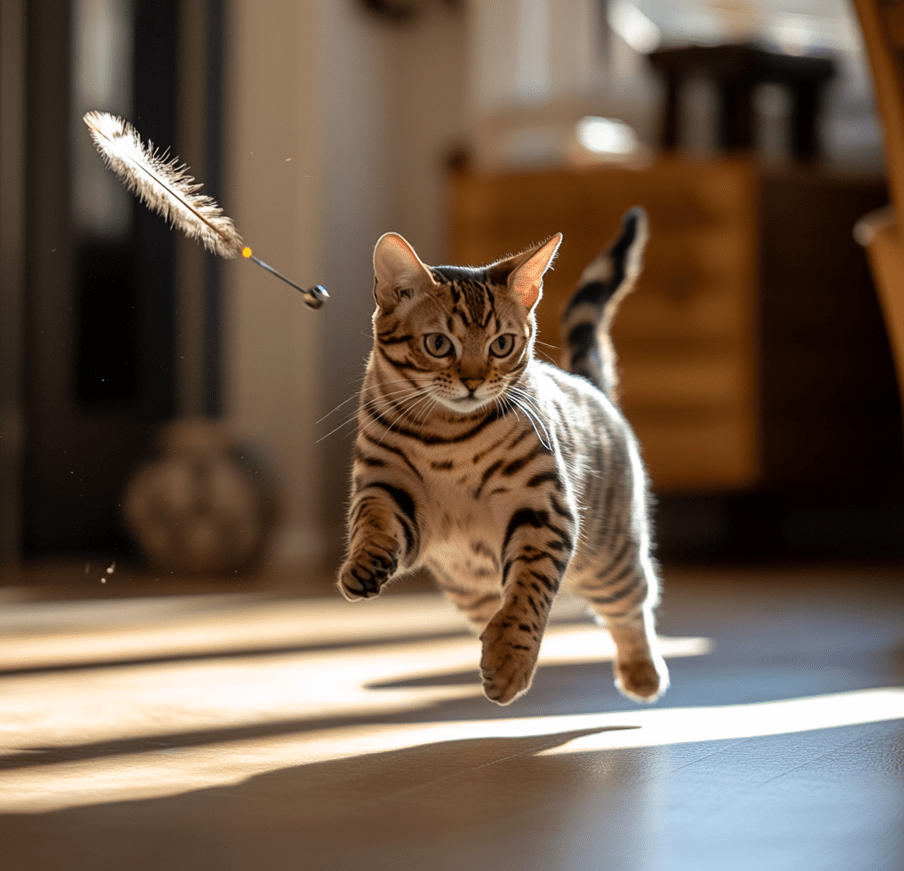
A sensitive stomach doesn’t have to define your Bengal cat’s life. By understanding the causes—whether dietary, medical, or stress-related—and implementing tailored solutions, you can help your Bengal feel their best. From choosing the right food to creating a stress-free environment, every step you take supports their digestive health and strengthens your bond. Work closely with your veterinarian, stay observant, and trust that your efforts will make a difference.
For more resources, check with trusted organizations like the Cat Fanciers’ Association or consult a feline nutritionist. Your Bengal’s vibrant spirit deserves a healthy, happy life, and with the right care, they can thrive.

